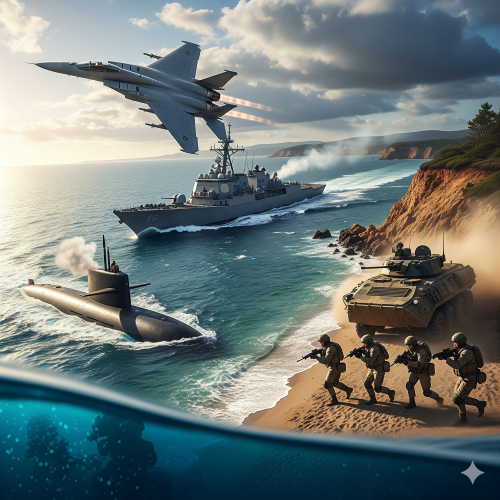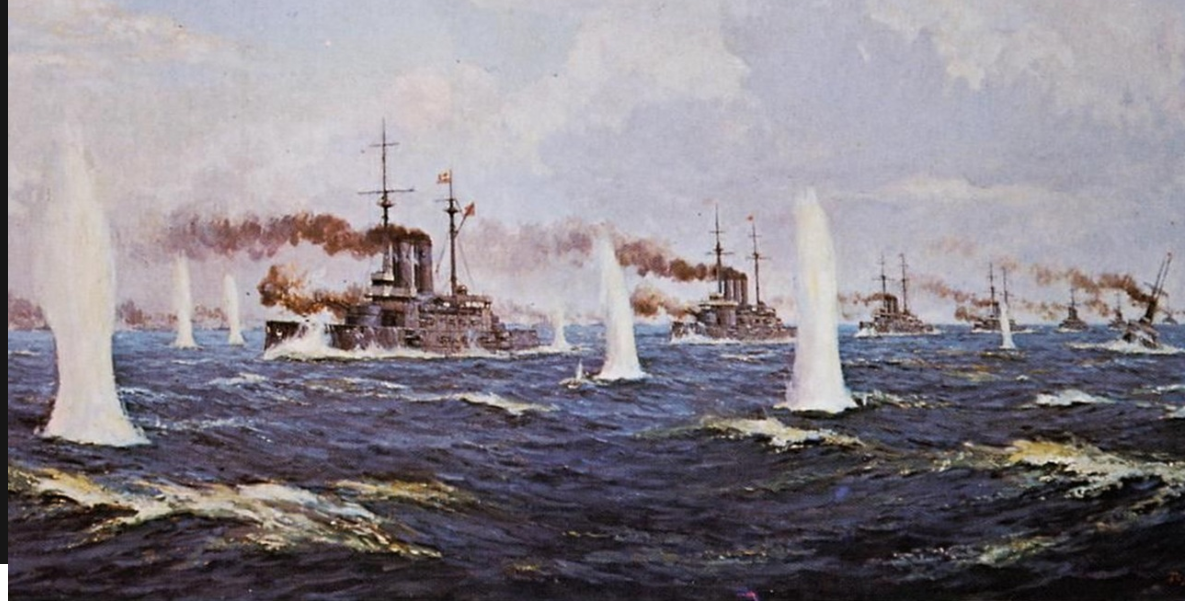The Three Outcomes of the Battle of Tsushima

Tsushima helped a rising Asian power consolidate its regional standing, set that power on the path to destruction in World War II, and fired anti-imperial passions the world over.
All battles change history. A scant few have world-historical impact. The Battle of Tsushima (1905) falls into the latter category. This encounter in the waters separating Japan from Korea pitted the Imperial Japanese Navy’s (IJN) Combined Fleet against the Russian Second Pacific Squadron, a.k.a. its Baltic Fleet. Tsushima delivered “command of the sea” to the victor, cementing Imperial Japan as Asia’s predominant indigenous power while sweeping Russian sea power from the Far East for generations to come. The battle also etched itself on IJN culture as the way to combat a stronger yet faraway foe. And, not least, Tsushima began reversing centuries of European imperial dominance of Asia.

This was a tectonic clash in both military and cultural terms.
Japan Annihilated the Russian Navy at Tsushima
First, the immediate results. Command of the sea, of course, is a phrase most commonly associated with nautical sage Alfred Thayer Mahan. Mahan defined command as “overbearing power on the sea which drives the enemy’s flag from it, or allows it to appear only as a fugitive; and which, by controlling the great common, closes the highways by which commerce moves to and from the enemy’s shores.” He concludes that “this overbearing power can only be exercised by great navies.” The Mahanian concept connotes permanent, absolute control of important expanses. A multitude of options come with command, from squelching a foe’s seagoing trade to bring the economic hurt, to mounting amphibious landings on hostile shores, to opening new combat theaters to stretch out, divide, and enfeeble defenders.
Winning command is a blessing.
Alongside the Royal Navy’s triumph at the Battle of Trafalgar (1805), Tsushima set the gold standard for Mahanian maritime command. After the Russian Navy lost its Pacific Squadron to Japanese arms in the Yellow Sea in the summer of 1904, Tsar Nicholas II dispatched the Baltic Fleet on an epic 18,000-mile voyage from northern Europe to the combat theater via the Cape of Good Hope, the Indian Ocean, and the South China Sea. Impoverished of logistical support—Great Britain, which controlled the vast majority of naval coaling stations on the route to Asia, was an ally of Japan—the exhausted and dispirited Baltic Fleet arrived in the Tsushima Strait on May 27, 1905, only to confront a freshly refitted and well-rested IJN Combined Fleet prowling home waters. Overseeing the Japanese fleet was Admiral Heihachirō Tōgō, who ranks among naval history’s most famed commanders. Two days of gunfire and torpedo attacks left the vast bulk of the Baltic Fleet captured or strewn across the seafloor. Its few remnants fled to Vladivostok or neutral seaports, there to pose no further threat to Japanese sea command.
Japanese ground forces rumbled on to victory in the Russo-Japanese War, their maritime supply lines from the home islands safe.
The Tsushima Doctrine Led Directly to Pearl Harbor
Second, institutional culture. Fury greeted the peace settlement among the Japanese populace, chiefly because the political leadership in Tokyo had led them to believe St. Petersburg would deliver a massive indemnity to repay the sacrifices ordinary Japanese had made during the war. Japanese arms prevailed—but not in such resounding fashion that Russia would accept such humiliation. Rioting convulsed the island nation.
For the naval high command, however, a triumphal afterglow came to enshroud memories of Tsushima. In fact, I have maintained that a strategic meme leapt from mind to mind throughout the leadership, and that the leadership codified the meme in doctrine and strategy. Tsushima speedily became the scenario for how the IJN would fight the US Navy, Japan’s next major contender in the Pacific. Japanese strategists expected to spring a repeat of Tsushima on a US Pacific Fleet weary from transiting the vast emptiness of the Pacific Ocean to the Philippine Islands—a US colony at the time—while under fire from submarines and island-based warplanes. The meme became dogma during the interwar decades.
In fact, President Theodore Roosevelt sent the US Navy battle fleet, the “Great White Fleet,” on a world cruise (1907-1909) to debunk the Tsushima meme. The US fleet tarried in Japan along its westward voyage in large part to disabuse Japanese leaders of the notion that the US Navy would play the part of the Baltic Fleet in a future showdown. TR hoped to show the Japanese that heavy US Navy forces could make the long trans-Pacific journey without incident and arrive in Far Eastern waters fit to fight. In so doing, he hoped to deter Tokyo from potential aggression.
Whether his message had the desired effect is doubtful. After all, a revolution in battleship design was transforming navies in Europe. The Great White Fleet was made up of “pre-dreadnought” battlewagons overtaken by technology when the Royal Navy’s HMS Dreadnought—a revolutionary all-big-gun, fleet-of-foot capital ship powered by turbines rather than clunky reciprocating steam engines—slid down the ways in 1906. Technological change took much of the political force out of Roosevelt’s deterrent gesture.
In any case, dispelling a strategic meme is far from easy. So entrenched was this one that rerunning Tsushima remained central to Japanese war planning until 1941, when Admiral Isoroku Yamamoto invested his immense personal prestige in convincing the supreme military leadership to embrace the preventive strike on Pearl Harbor—envisioned as a single crippling blow that would annihilate the US Navy and give command of the sea to Japan for the duration of the war.
Tsushima Was Asia’s First Victory over Europe
And third, cultural and social impact. The Battle of Tsushima reverberated well after the clangor of arms had fallen silent in May 1905, and well beyond maritime East Asia. In his sprightly and insightful treatise From the Ruins of Empire, scholar Pankaj Mishra maintains that the bloodletting “seems to have struck the opening chords of the recessional of the West.” How so? Think about it. The Russo-Japanese War marked the first time in over four centuries that an Asian power had vanquished a European empire. During the Ming Dynasty, imperial China fielded the world’s largest, most technologically advanced fleet, the “treasure fleet.” During the early fifteenth century, Ming admiral Zheng He led the fleet on a series of long-distance voyages of diplomacy, commerce, and discovery spanning such expanses as the South China Sea, the Indian Ocean, and possibly the Persian Gulf. There is a stone tower of mysterious origin in downtown Newport, Rhode Island. Some commentators insist Zheng He came to southern New England and built it!
Whimsical tales aside, Zheng He remains an icon in China to this day. At one time not long ago, owing to his popularity, Chinese Communist Party potentates strove to make the ancient mariner the face of Chinese sea power.
For reasons that historians debate to this day, the Ming Dynasty turned inward after Zheng He’s rousing voyages, ordered the treasure fleet broken up, and forbade further sea voyages. By historical happenstance, at almost the same time China evacuated the seas—India having done the same a century before—Portuguese adventurer Vasco da Gama anchored along the subcontinent’s coast. In so doing da Gama ushered in the age of European primacy in Asia. Asians won no victories of consequence for centuries until the Russo-Japanese War—with Tsushima marking the climax—showed it could be done. All of a sudden, Asians could defeat Westerners.
Japan found admirers in unlikely places in the wake of Tsushima. Mishra points out that Sun Yat-sen, the father of both the Chinese Nationalist Party and the Chinese Communist Party, lauded Japanese martial prowess. Mao Zedong, the founding chairman of the Chinese Communist Party and an avowed foe of imperial Japan, likewise found a kind word to say about the island state. Mahatma Gandhi was an admirer, as was Turkey’s Kemal Atatürk. Tsushima rippled even into the nascent American civil-rights movement, inspiring the likes of W. E. B. DuBois.
A local battle for maritime command in a limited regional war helped a rising Asian power consolidate its regional standing, set that power on the path to destruction in World War II, and fired anti-imperial passions the world over. Seldom do you come across a Tsushima—a tactical engagement with long-lasting political import.
But so it was.
- Questions and Answers
- Opinion
- Motivational and Inspiring Story
- Technology
- Live and Let live
- Focus
- Geopolitics
- Military-Arms/Equipment
- Beveiliging
- Economy
- Beasts of Nations
- Machine Tools-The “Mother Industry”
- Art
- Causes
- Crafts
- Dance
- Drinks
- Film/Movie
- Fitness
- Food
- Spellen
- Gardening
- Health
- Home
- Literature
- Music
- Networking
- Other
- Party
- Religion
- Shopping
- Sports
- Theater
- Health and Wellness
- News
- Culture

